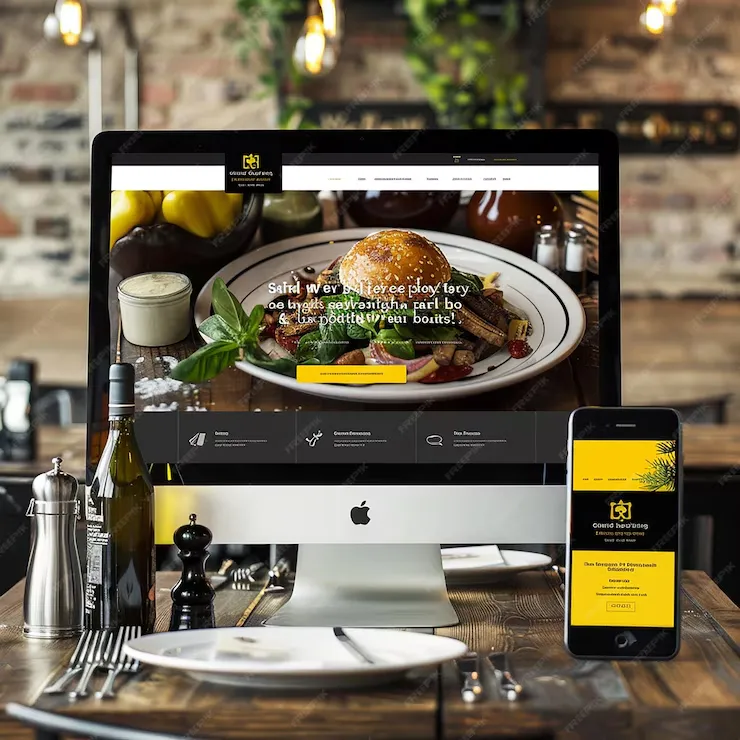In the digital age, having an online presence is essential for any restaurant looking to attract more customers and stay competitive. Creating a website is not enough; it must be optimized for SEO (Search Engine Optimization) to ensure it appears in search results and that customers can easily find it. This article will guide you through the entire process of creating a website for your restaurant, from the initial design to advanced SEO optimization, including examples of successful restaurant websites.
1. Sketch the Website Design
The first step in creating a restaurant website is to sketch out a clear design that meets your business goals. The design should not only be visually appealing but also functional and easy to navigate. Here’s how to do it:
Define Your Goals
Before you start designing, clearly define your website’s goals. Do you want visitors to make online reservations? Do you want them to order takeout? Or is it more important to showcase your menu and location? Defining these goals will help you make design decisions that align with your business objectives.
Identify the Target Audience
Knowing your audience is key. You need to identify who your ideal customers are. Are they families, young adults, executives, tourists? Depending on your audience, the website design and content should be tailored to attract these specific groups.
Choose a Website Building Platform
There are several platforms available for building your website. Some of the most popular ones are WordPress, Wix, and Squarespace. WordPress is ideal if you seek flexibility and SEO control. Wix and Squarespace are great options if you prefer a simpler setup with predefined templates.
Design the Site Structure
A sitemap is a blueprint that shows the structure of all the pages on your website. Creating a sitemap before you start will allow you to organize content logically and ensure that navigation is intuitive for users.
Select a Theme or Template
Choose a theme or template that is responsive, meaning it will adapt to different screen sizes, including mobile devices and tablets. Ensure the theme is SEO-friendly from the start to avoid problems later on.
Plan the Navigation
Navigation should be simple and straightforward. Menus should be clearly organized, with sections such as “Home,” “Menu,” “Reservations,” “Contact,” and “Blog” visible at the top of the page.
2. Keyword Research
Keyword research is fundamental to your website’s SEO success (Here you can get a list of 150 SEO keywords for restaurants). Here’s how to do it effectively:
Find Main Keywords
Use tools like Google Keyword Planner, SEMrush, or Ahrefs to find the most relevant keywords related to restaurants in your area. Keywords like “restaurant in [your city]” or “[specific cuisine] near me” are good starting points.
Identify Long-Tail Keywords
Long-tail keywords are more specific phrases that tend to have less competition. For example, “Italian restaurant with vegan options in [your city]” is a more specific keyword that can attract a more qualified audience.
Use SEO Tools
Tools like SEMrush and Ahrefs will not only help you find keywords but also allow you to analyze keyword traffic, competition, and ranking opportunities.
Competitor Analysis
Analyze the websites of your direct competitors to see which keywords they are using. This can give you ideas on what terms to include in your content strategy and how to differentiate yourself from them.
3. Content Creation and Optimization
Content is the backbone of your website and must be optimized for SEO from the start. Here’s how to do it:
Write High-Quality Content
Each page on your site should have unique, high-quality content. Ensure the content is relevant to your visitors and addresses their needs or questions. For example, provide detailed descriptions of your dishes on the menu page or explain your culinary philosophy on the “About Us” page.
Optimize Headings
Use keywords in your page headings. The main heading (H1) should include the primary keyword, while subheadings (H2, H3) can include variations or secondary keywords. This helps Google understand the structure and relevance of your content.
Incorporate Keywords Naturally
It’s important that keywords are incorporated naturally into the text. Avoid “keyword stuffing,” which is the practice of including too many keywords in an attempt to manipulate search rankings. Google penalizes this practice, which can harm your SEO.
Write Effective Meta Descriptions
Meta descriptions don’t directly influence rankings, but they are crucial for increasing click-through rates. Make sure they are compelling, include the keyword, and end with a call to action.
Incorporate Visual Content
Images and videos can enhance the user experience, but they also need to be optimized. Use descriptive file names and alt tags for images, ensuring they include relevant keywords. This not only helps with SEO but also improves site accessibility.
4. On-Page SEO Optimization
On-page SEO optimization is the process of improving elements within your website to make it more search engine friendly:
Title Tags and Meta Descriptions
Title tags are one of the most important SEO factors. Ensure that each page has a unique title tag that includes the main keyword. Meta descriptions should complement title tags and offer a concise summary of what the page is about.
URL Optimization
Your page URLs should be short, descriptive, and contain keywords. For example, instead of having a URL like “www.yourrestaurant.com/page1,” an optimized URL would be “www.yourrestaurant.com/italian-menu.”
Proper Use of Alt Tags in Images
Alt tags not only improve website accessibility for visually impaired users but also help search engines understand what the images are about. Always include a precise and relevant description that incorporates keywords when possible.
Page Speed Optimization
Page load speed is a critical factor for SEO. Google favors sites that load quickly because they provide a better user experience. Use tools like Google PageSpeed Insights to analyze your site’s speed and make necessary improvements, such as compressing images and minimizing code.
Implementation of Microdata and Rich Snippets
Microdata helps search engines better understand your content. Implement rich snippets for elements like reviews, recipes, and events to make them stand out in search results with additional information, such as star ratings or preparation times.
5. Off-Page SEO Optimization
Off-page SEO optimization involves improving your website’s perception through external activities, helping to increase its authority and visibility in search engines:
Link Building Strategies
Link building is the process of acquiring links from other websites to your own. High-quality backlinks are crucial for improving your ranking in Google. Collaborate with food bloggers, local media, and other relevant sites to get links.
Register in Local Directories and Google My Business
Register your restaurant on Google My Business and local directories like Yelp, TripAdvisor, and Zomato. Make sure all information is accurate and up-to-date. This not only improves your visibility in local searches but also makes it easier for customers to find your restaurant.
Review and Testimonial Management
Online reviews play a fundamental role in a potential customer’s decision-making process. Respond to reviews, both positive and negative, and use these interactions to improve public perception of your business. Reviews are also a ranking factor for local SEO.
Collaborations and Influencer Marketing
Influencer marketing can be an excellent way to generate backlinks and increase your site’s visibility. Work with local food bloggers and influencers who can review your restaurant and share it with their audience.
Use of Social Media
Social media doesn’t directly affect SEO, but it can drive traffic to your website. Share engaging content on platforms like Instagram, Facebook, and Twitter, and use relevant hashtags to increase your reach.
6. User Experience (UX) and Page Speed
A great user experience and fast page load speed are essential for both keeping visitors on your site and for SEO:
Responsive Design
Responsive design ensures that your website looks and works well on any device, whether it’s a desktop computer, tablet, or mobile phone. Since a significant number of users will visit your site from their phones, it’s crucial that the mobile experience is smooth and hassle-free.
Enhance User Interaction
Ensure that the primary actions, such as making a reservation or ordering food online, are easy to perform. Use clearly visible call-to-action (CTA) buttons and forms that are easy to complete.
Page Load Speed Optimization
Page load speed is a decisive factor in user retention. Studies show that most users will abandon a site if it takes more than 3 seconds to load. Compress images, minimize scripts, and use a reliable hosting service to improve your site’s speed.
A/B Testing Strategies
Implement A/B testing to continuously optimize the user experience. A/B testing allows you to compare two versions of a page or specific element to see which one performs better. Use these tests to improve conversion rates and user satisfaction.
7. Creating Key Pages
Each page on your website should be designed to serve a specific purpose and optimized for SEO:
Home Page
The home page is your restaurant’s first impression. It should include an engaging summary, high-quality images of your dishes, and links to the most important pages like the menu and reservations. Make sure it is optimized with keywords and offers easy navigation.
Menu Page
The menu is one of the most visited pages on a restaurant website. Ensure it is easy to read and navigate. Include detailed descriptions of dishes, ingredients, options for special diets, and prices. Use attractive images and alt tags to enhance SEO.
Reservations and Orders Page
This page should make it easy for users to make reservations or place orders. Include an easy-to-use reservation form, or if you offer online ordering, ensure the process is smooth and fast. Optimize this page with keywords related to reservations and online orders.
Contact Page
The contact page should include all relevant information, such as address, opening hours, phone number, and a contact form. It’s also useful to include a Google map to make it easier for customers to find your location. Optimize this page for local searches.
Blog
A blog is a powerful tool to attract organic traffic and keep your customers informed. Regularly publish content about events, special offers, restaurant stories, and recipes. Use keywords in blog posts and share the articles on your social media to increase their visibility.
8. Website Maintenance and Updates
Continuous website maintenance is crucial to keeping it relevant and performing well:
Monitor SEO Performance
Use tools like Google Analytics and Google Search Console to monitor your website’s performance. Analyze key metrics such as traffic, bounce rate, and conversions. Make data-driven adjustments to continually improve your SEO.
Regular Content Updates
Keep your website content updated so it remains relevant to visitors and search engines. Add new blog posts, update the menu and promotions, and review key pages to ensure all information is current.
Continuous Review and Optimization
Search engine algorithms are constantly changing, so it’s important to regularly review and adjust your SEO. Conduct periodic SEO audits to identify areas for improvement and stay on top of the latest SEO trends.
Website Security
Security is a fundamental aspect for both user trust and SEO. Ensure your website is protected with an SSL certificate, perform regular backups, and keep all plugins and themes up to date to prevent vulnerabilities.
9. Examples of Restaurant Websites with Good SEO
Here are five examples of restaurant websites that have successfully implemented SEO:
Sweetgreen
- Optimization: Sweetgreen stands out for its fast loading speed, clean design, and focus on local keywords. Their blog on sustainability and nutrition helps attract a specific audience and improve their SEO.
Chipotle Mexican Grill
- Optimization: Chipotle uses well-defined SEO strategies, such as specific keywords in their content and image optimization. Their integration with Google My Business is solid, increasing their visibility in local searches.
Olive Garden
- Optimization: Olive Garden features a detailed and SEO-optimized menu with rich keyword descriptions. They also focus on local SEO with a well-optimized Google My Business profile.
The French Laundry
- Optimization: This site focuses on an exceptional user experience and high-quality content. The pages are visually appealing and optimized with specific keywords and narrative content.
Nobu Restaurants
- Optimization: Nobu combines excellent image optimization with a clean and SEO-friendly site structure. The content is carefully curated to reflect the luxury brand and attract its audience.
10. Conclusion
Creating a restaurant website that is visually appealing and well-optimized for SEO requires strategic planning and execution. From the initial design to technical optimization and off-page SEO strategies, each step is crucial to attracting traffic and converting visitors into customers.
By following the steps outlined in this article and studying successful examples, you can ensure that your website not only stands out visually but also ranks well in search engines, helping your restaurant grow and thrive in the competitive digital market.






